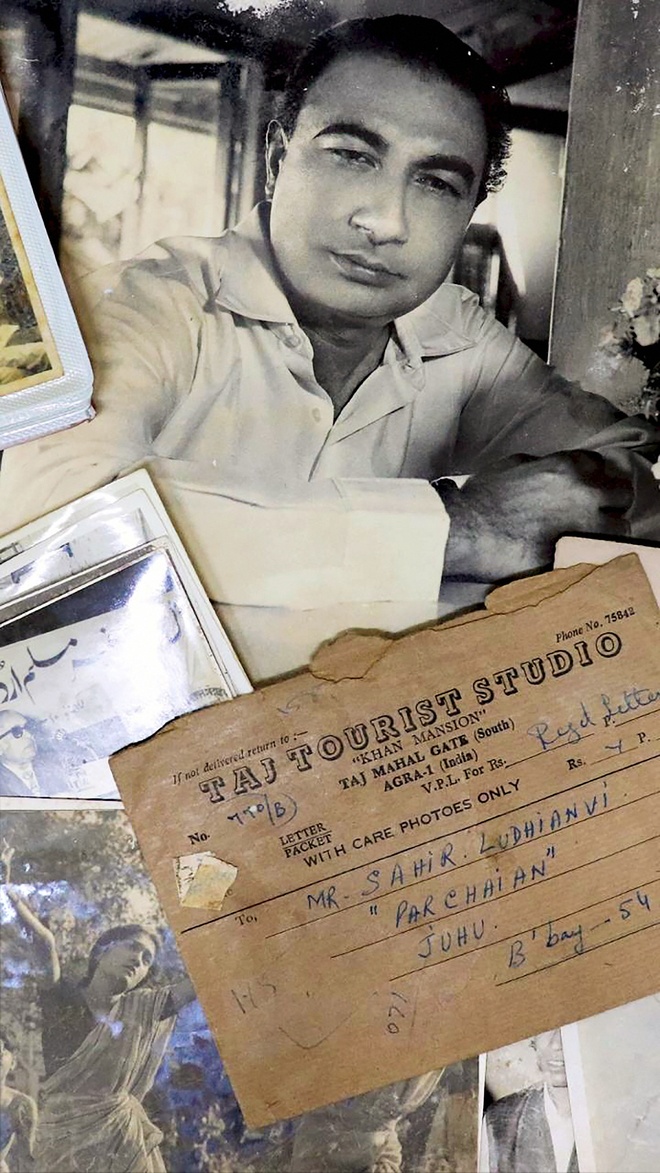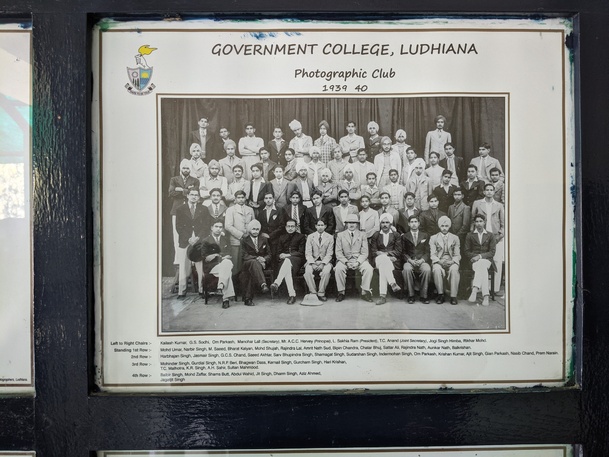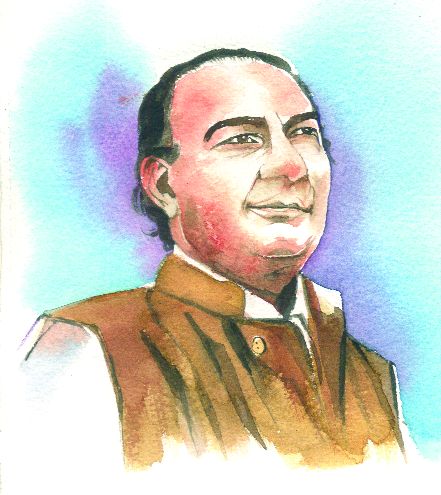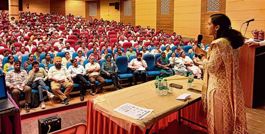
Dishonouring his legacy: Sahir Ludhianvi’s handwritten notes, letters, poems and photographs were found from a scrap shop in 2019 in Mumbai
Renu Sud Sinha
Born Abdul Hayee a hundred years ago, he called himself Sahir (meaning sorcerer, wizard, enchanter and magician) when the world started taking note of the magic of his words. As was the literary tradition those days, like Urdu poets Majrooh (Sultanpuri), Josh (Malihabadi), Firaq (Gorakhpuri), Daag (Dehlvi), he added the city of his birth as takhallus (pen-name) and a magician was born. In the preface to his book, ‘Sahir: A Literary Portrait’ (2019), Surinder Deol calls him ‘a mystery wrapped in an enigma’.
Akshay Manwani, who authored ‘Sahir Ludhianvi: The People’s Poet’ (2013), the first-ever comprehensive biography in English, agrees. “He wasn’t a vanilla character. His life story was full of dramatic elements.”

Raised amid poverty by a single mother, Sahir couldn’t acquire a college degree, despite enrolling in three institutions. Yet , he went on to become a noted poet and film lyricist with a cult status in an industry not known to celebrate lyricists till then. He was known to have numerous affairs but found no lasting love in his life. A Marxist and an atheist, despite his unequivocal condemnation of religion, particularly after witnessing the horrors of Partition, he gave us some of the most beautiful bhajans.

Baffling love story
The biggest mystery that has, at times, overshadowed even the literary merit of his works has been the incomplete love story of Sahir-Amrita Pritam. The tragic tale has been the subject of numerous plays and even a likely biopic that would have been the perfect centenary tribute had Covid-19 not struck.
Deol, who has critically appraised and translated a selection of over 90 of Sahir’s poems, nazms, ghazals and bhajans in his book, tries to explain the mystery. Quoting Ahmed Rahi, Sahir’s friend from Lahore, he says, “Sahir only loved one woman, his mother, and had only one hate, his father.”
“Sahir never openly acknowledged his relationship with Amrita due to many reasons. When they initially became friends in Lahore, Sahir had no money, no job and Amrita was a rich man’s wife, used to all comforts of life and he could offer her nothing. Later, when he came to Bombay and achieved material success, he knew how much he loved Amrita and was perhaps afraid that it would create a conflict in his relationship with his mother,” says Deol.
Sahir has also often been accused of moving away from pure literature after he achieved fame and wealth. Prof Gopi Chand Narang, former president, Sahitya Akademi and Professor Emeritus, Jamia Millia Islamia, says, “Sahir stopped writing new poetry and contributing to literary magazines after he moved to Bombay. ‘Talkhiyan’, written when he was just 23, and later ‘Parchhaiyan’ (1956) remain his only two major literary works. ‘Talkhiyan’, which contains his famous poem ‘Taj Mahal’ (Ik shahanshah ne daulat ka sahara le kar ham garibon ki mohabbat ka udaya hai mazaq), sold 23 Urdu editions within two years of its publishing. Sahir would justify, ‘I didn’t get anything from my poetry but my film lyrics gave me everything’.
“His childhood was spent in poverty. When he succeeded, Sahir became arrogant,” says Narang. Deol agrees: “This arrogance cost him many friends and successful professional relationships such as those with SD Burman, Jaidev and Lata Mangeshkar. ‘Pyaasa’, loosely based on Sahir’s life, was a milestone, but Burman and Sahir never worked together again,” he points out.
Manwani, however, is quick to defend the poet-lyricist. “He was a man of contradictions. If he was quick to insult, he would apologise as quickly. If he alienated the best of music directors, there were many others like Khayyam, Ravi and N Datta who found fame because of him.”
His friend and publisher, Delhi-based Amarnath Verma, agrees. “During a visit to Bombay, I requested him to introduce me to some established authors. Sahir personally took me to Krishan Chander and Rajinder Singh Bedi. On another visit, Gulshan Nanda was with me. Nanda asked me to request Sahir to recommend him to film directors. When I asked Sahir, he himself came to meet Nanda and later helped him in getting work.”
Atheist bhajan writer
Sahir was a member of the Progressive Writers’ Movement. A staunch secularist, he did not practise any religion, yet the bhajans he wrote remain popular — “Allah tero naam”, “Tora mann darpan kehlaye”, “Aan milo Shyam”, “Aaj sajan mohe ang laga lo”. Deol shares an interesting anecdote. “Sahir had heard Gurbani in school. To him, it meant that only gurus could write hymns. Once a producer asked him to write a bhajan. In panic, Sahir called his friend Firaq Gorakhpuri to come to Bombay and help him. Firaq, who was fluent in Sanskrit, taught him the rudiments. For Sahir, it was more of a challenge than any devotion on his part, but in the process, he created some beautiful bhajans.”
Like his bhajans, has his poetry withstood the test of time and resonates with today’s youth? While his ardent followers like to believe so, others differ. Ludhiana-based Dr Kewal Dhir has been celebrating Sahir’s poetry and legacy for half a century now as an annual mushaira called ‘Jashn-e-Sahir’. “There has been an increase of youth among audience in the past three to four years,” says Dr Dhir.
However, the octogenarian is worried about the absence of young torch-bearers to pass on the baton of his legacy that even Ludhiana has not cared to preserve. There is no bust of the poet in city nor a road named after him. Only his alma mater, Government College, Ludhiana, where Sahir studied philosophy and history as well as economics and politics from 1937 to 1943, has renamed its auditorium after its famous student. There is also a small botanical garden in the college called Gulistan-e-Sahir that was created in 1990. On his 100th birth anniversary on March 8 this year, only his college held a small event to commemorate his memory.
Literary canons change with time, adds Narang. Manwani agrees, “Language of every era is different. Tastes change.” Deol puts across an even more valid reason — the diminishing popularity and reach of Urdu among youth in India. “In Pakistan, Sahir is well known. His ‘Talkhiyan’ is part of the curriculum,” he says.
But we should let Sahir have the last word:
“Kal aur aayenge... Mujhse behtar kehne wale, tumse behtar sun ne wale...”
Join Whatsapp Channel of The Tribune for latest updates.



























